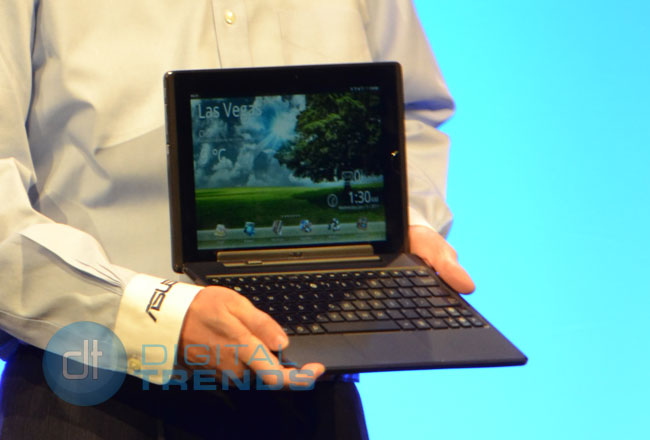
In a show that has already seen its share of iPad wannabes attempting to elbow in on the tablet spotlight, it will take more than a flashy screen and a thin body to stand out. Emphasizing the choice in its model line, Asus launched three new Android-powered Eee Pad models on Tuesday, including one with a sliding keyboard and another that turns into a quasi-laptop, that will attempt to do just that.
Eee Pad MeMO
The most straightforward of the bunch, Asus’ Eee Pad MeMo uses a seven-inch capacitive screen, Qualcomm Snapdragon processor from the smartphone parts bin, and runs Android 3.0 Honeycomb. The most notable spec might be the IPS screen – the same high-end display tech used in the iPad and a common thread among all three of Asus’ latest tablet offerings. In an unusual throwback to pre-iPhone days, it also includes a built-in stylus. It will retail between $499 and $699 in July.

Eee Pad Transformer
Moving up a peg in size, the Asus Eee Pad Transformer stays true to its namesake by transforming into a miniature laptop when you add a mobile docking station, similar to the Lenovo IdeaPad U1 we saw at CES 2010. Besides adding a keyboard, the docking station also imbues it with a claimed 16 hours of battery life. Even without it, the Transformer offers a 1.2-megapixel front camera, 5-megapixel rear camera, and a built-in mini HDMI port – potentially useful considering Nvidia’s Tegra 2 processor supplies it with enough grunt for smooth 1080p playback. The screen measures 10.1 inches, offers 1280 x 800 resolution, and without the docking station, Asus claims the Transformer measures just 12.98mm, making it thinner than the iPad. Asus will begin offering it in April for between $399 and $699.

Eee Pad Slider
Reinforcing an emphasis on choice that included a not-so-subtle jab at Apple, the Eee Pad Slider will offer nearly identical specs to the Transformer, but with a slide-out QWERTY keyboard rather than a full docking station. A slide-out keyboard on a 10.1-inch tablet? Indeed. And possibly as awkward as it sounds. The Slider includes a fold-out stand on that back that makes it possible to prop it up, but the pint-sized keyboard still looked awkward to type on, and produced a couple mistakes even during the carefully orchestrated on-stage demo. Despite the extra feature, though, Asus has kept weight to just 1.98 pounds, and thickness to a hair under 2/3 of an inch. The Slider will be available in May for between $499 and $799.




